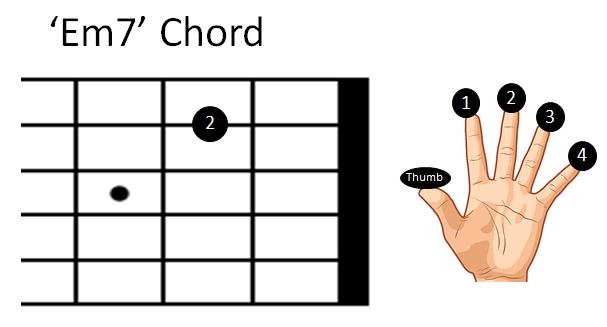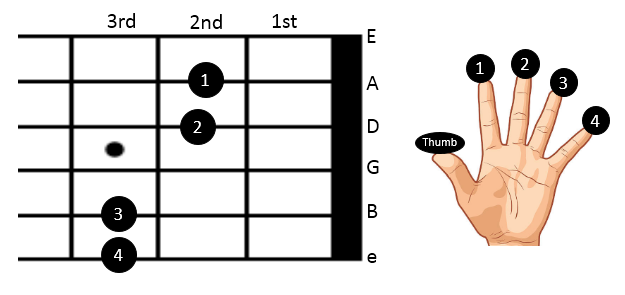
1. Basic Fingering:
- Open Position:
To play the Em7 chord in the open position,
place your middle finger on the 2nd fret of the A string (5th string),
and let the rest of the strings ring open. Your index finger should not be used,
and the high E string (1st string) should be played open.

Alternate Fingering:
Another common way is to play Em7 by
placing your index finger on the 2nd fret of the A string (5th string),
your middle finger on the 2nd fret of the D string (4th string).
your ring finger on the 3rd fret of the B string (2nd string)
your little finger on the 3rd fret of the e string (1st string)
Strum from the E string down, letting the low E and G strings ring open.
2. Smooth Transitions:
- Practice Chord Changes: Em7 often appears in progressions with other chords such as Cmaj7, Am7, or G7. Practice transitioning between these chords to build fluency.
- Use a Metronome: Start with a slow tempo to get comfortable with the finger positions and gradually increase the speed.
3. Strumming Patterns:
- Explore Different Rhythms: Experiment with various strumming patterns, including downstrokes, upstrokes, and combinations. Em7 can sound great with different rhythmic approaches.
- Focus on Dynamics: Vary the intensity of your strumming to add expression. Play softly for a mellow sound or more forcefully for a brighter tone.
4. Fingering Techniques:
- Finger Placement: Ensure that your fingers are pressing down firmly and close to the frets without muting adjacent strings. This helps achieve a clean sound.
- Avoid Unwanted Muting: Be mindful of your finger placement to avoid accidentally muting strings that should ring open.
5. Practice with Common Progressions:
- Chord Progressions: Practice Em7 within common chord progressions like Em7 – A7 – D7 – G7 or Em7 – Cmaj7 – Am7 – B7. This helps you understand how the chord functions in different musical contexts.
- Experiment with Keys: Play Em7 in different keys by using a capo. This can help you see how the chord works in various musical settings.
6. Listen and Learn:
- Songs Featuring Em7: Listen to songs that prominently feature the Em7 chord, such as “Hotel California” by Eagles or “Wonderwall” by Oasis. Playing along with these tracks can help you understand the chord’s role in music.
- Analyze Different Styles: Em7 is used in various genres like jazz, pop, and rock. Study how different styles utilize the chord to expand your musical knowledge.
7. Advanced Variations:
- Barre Chord Version: You can play Em7 as a barre chord by barring all strings at the 7th fret with your index finger and using your ring finger to press the 9th fret on the A string (5th string). This provides a fuller, more complex sound.
- Add Extensions: Experiment with adding notes like the 9th (F#) or 13th (C) to create more complex chords like Em9 or Em13.
8. Use Visual Aids:
- Chord Diagrams: Refer to chord diagrams and fretboard charts to understand the finger positions and notes involved in the Em7 chord.
- Practice Apps: Utilize guitar practice apps that provide visual representations and feedback on your chord playing.
By incorporating these tips and techniques into your practice routine, you’ll develop a stronger grasp of the Em7 chord and how to use it effectively in your music.

One thought on “Em7 Guitar Chord: Easy Tutorial for Beginners and Pros”